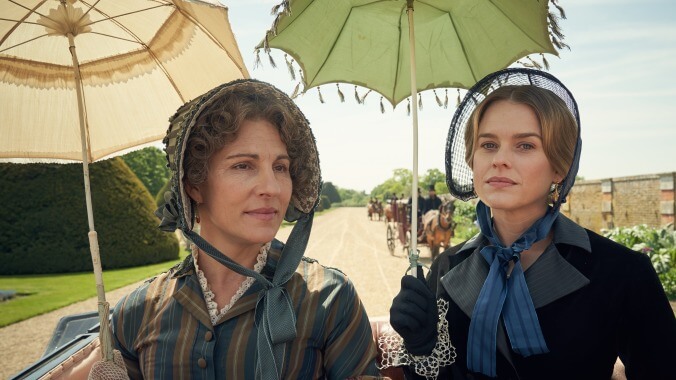

It’s not until the very end of its premiere episode that it becomes clear what kind of show Belgravia is going to be. When it opens, the new miniseries from Downton Abbey creator Julian Fellowes is a sweeping wartime romance set in 1815 Brussels against the heady backdrop of an infamous real-life ball held just two days before Napoleon’s defeat at the Battle Of Waterloo. The bulk of the series, however, is set 26 years later in the early 1840s in London’s affluent Belgravia neighborhood, a newly created “spangled city for the rich.” In place of the attractive young romantic leads, we follow their aging parents as they reflect back on what transpired in the previous two and a half decades. Belgravia is a mystery, but it’s even more so a memory play about regret, family secrets, and the consequences of repression.
The six-episode miniseries is adapted from Fellowes’ novel of the same name, which he published in cliffhanging installments back in 2016. Between the book’s sprawling multi-generational ensemble and its class-focused Victorian setting, Belgravia is clearly Fellowes’ attempt to do Charles Dickens. In the vein of Great Expectations and David Copperfield, there’s even a young unassuming man named Charles Pope (Jack Bardoe) whose past and future sits at the center of it all. Though Belgravia doesn’t come anywhere close to reaching the heights of Dickens’ masterful storytelling, it proves an imperfect copy of greatness can have its pleasures too.
Though Belgravia airs on Epix, the cozily familiar period drama would feel equally at home among Downton’s old PBS Masterpiece branding. At the center of its story are two middle-aged women. One is anxious nouveau riche Anne Trenchard (Tamsin Greig), whose husband made his now-substantial fortune supplying food and materials during the Napoleonic Wars. The other is the unflappable Countess Of Brockenhurst (Harriet Walter), who comes from the oldest of old money. Their children are the young lovebirds who provocatively transcend class boundaries in the prologue. Since both offspring died in and around the war, however, Anne and Lady Brockenhurst bond in lingering grief when they finally meet years later. Yet it turns out Anne knows more than she’s letting on, and her long-kept secrets become the narrative drive of the series.
When Belgravia focuses on the relationship between its two central women, it’s almost always a smashing success. Greig and Walter nimbly shift between Fellowes’ impulse for catty, gossipy fun and his more grounded interest in lifelong grief. It’s refreshing to see a period drama centered on the sorts of characters who are often positioned as supporting players in younger, maler stories. Yet befitting his Dickens impression, Fellowes overstuffs his plot with a large ensemble who too often wind up muddying the waters with less successful tangents.
Anne’s world includes her bullish husband James (Philip Glenister), her oafish son Oliver (Richard Goulding), and her insincere daughter-in-law Susan (Alice Eve). Over on Lady Brockenhurst’s side of things, there’s her weary husband Peregrine (Tom Wilkinson, underused) and some scheming in-laws. Since the son the Brockenhursts lost in the war was their only direct heir, their estate is now destined for their caddishly immoral nephew, John Bellasis (Adam James, having a blast chewing the scenery). Elsewhere, the upstairs/downstairs balancing act Fellowes pulled off in Downton Abbey and Gosford Park finally goes awry, with undeveloped servants continually pulling focus from the much more successful upstairs stuff.
Though director John Alexander helms all six episodes, Belgravia often struggles to find a cohesive focus and tone. Part of the problem is that it just doesn’t quite have enough story to fill its six-episode run, and Fellowes too often stretches for time by going broader rather than deeper. One romantic subplot involves the eligible Lady Maria Grey (Ella Purnell)—a plucky young woman who seems to have accidentally wandered in from a much lighter show entirely. Though there are a few benefits to the extended runtime, like the unexpected depth Susan gains over the course of the series (Alice Eve’s strange energy is well deployed here), the source material might’ve been better served by a shorter run of episodes, if not just a film or TV movie adaptation. The second half of the series suffers as it moves away from the quiet interiority of Anne and Lady Brockenhurst to focus on showier melodrama involving the less interesting male characters.
As with Downton, Belgravia’s examination of the British class system is limited by Fellowes’ unending belief in the nobility of nobility. (John Lunn’s score is also distractingly similar to his work on that previous series.) Still, for period piece fans, Belgravia has more than enough gorgeous costuming and historical detailing to prove a satisfying diversion—particularly if you’re interested in 19th-century architecture or the invention of afternoon tea. Belgravia’s wildly varying tones and storylines provide a sort of all-you-can-eat buffet of period storytelling. While this sort of thing has been done better elsewhere (not least of all by Dickens himself), the show’s exploration of grief, motherhood, and the interior lives of middle-aged women is at least somewhat of a unique calling card. Belgravia may not always have a good sense of where its strengths actually lie, but they peek through all the same.